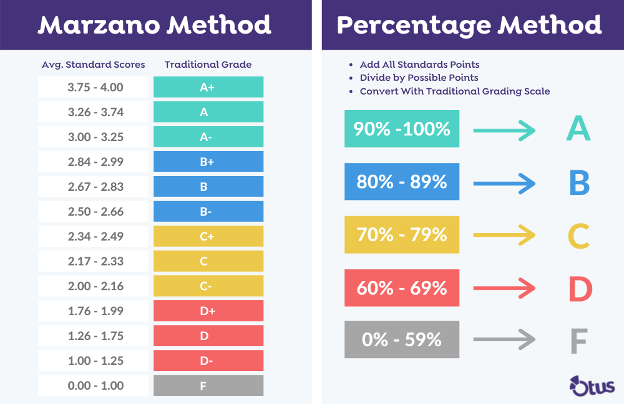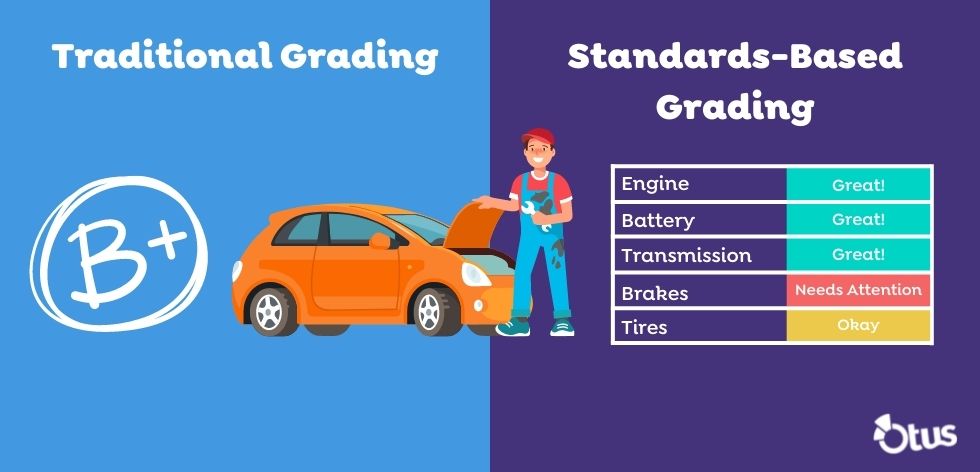The following blog was contributed by David Specht, Otus Senior EdTech Copywriter.
For over 100 years, the grades in our schools have not communicated what students have learned.
(Yes, you read that correctly.)
Those are the findings that Susan M. Brookhart and her colleagues reported in their 2016 research, “A Century of Grading Research: Meaning and Value in the Most Common Educational Measure,” and the conclusion that Matt Townsley, an assistant professor at the University of Northern Iowa and assessment/grading author, arrived at after reading Brookhart’s article.
“I was assigning points to students for things like bringing in a box of tissues,” said Townsley. “This has nothing to do with how much a student has learned in geometry. Similarly, assigning points for effort or completion is not the same as assigning points for how much a student has learned in class.”
In other words, “points for completion” don’t equal “points for learning.”
In recent history, a few things have happened that have shifted schools toward standards-based grading (SBG). Since the No Child Left Behind Act was signed into law in 2001, states, mostly for the first time, began to establish state standards. This meant that what one ninth-grade student was learning in their biology class was the exact same curriculum being taught to other ninth-grade biology students across their state. Most recently, the COVID-19 pandemic shed a unique light on instruction, causing many schools to begin to rethink grading. Some schools implemented what is known as Do No Harm Grading, acknowledging that there are inequities in grading, which we knew about before the pandemic, but that the pandemic amplified.
With all these factors, it became the perfect storm for schools to take a hard look at grading and think about doing it differently. But most schools have only ever used a traditional points grading system, so undoing this system is a challenge for educators not only internally as they work to understand and implement a new system but also externally in helping constituents understand it.
In a recent webinar, Matt Townsley identified and debunked common myths about SBG. As a former district administrator and secondary teacher in the Solon Community School District (Solon, IA), he has firsthand experience implementing and leading lasting grading reform. If you’re using SBG or are considering making the switch from traditional grading, here are three myths that you can prevent from taking hold in your school community.
Myth 1: SBG does not hold students accountable.
In a traditional grading system, if a student doesn’t submit an assignment, they receive a zero. Whether they understand the topic or not, their score of zero simply reflects the missing assignment. This is not an effective way to hold students accountable, and it also does not accurately communicate what the student does know, as there was never any evidence to evaluate. For schools using SBG, if a student isn’t progressing toward meeting the learning standards, there is an entire process they have to go through, and re-teaching opportunities are provided. In most cases, SBG involves more work and more accountability for students than traditional systems.

Myth 2: A student’s performance measured by SBG is difficult to transfer to other levels of education that may be using traditional grading.

High schools nationwide regularly use SBG and still report letter grades at the end of each semester. Colleges are familiar and fine with high schools that use SBG, even if they aren’t reporting letter grades. Furthermore, grading systems and styles often vary from one educator and system to another, teaching students the importance of being flexible and adapting as they move through their educational journey.
Myth 3: Traditional grading is more descriptive than SBG.

There is an allure of precision and objectivity to traditional grading systems and a myth of objectivity that comes with this. Many educators think that because they can calculate grades to a tenth of a percent, it’s better, but this simply isn’t true. Teachers can’t quantify learning because learning is qualifiable. For example, if we say a student has a 90% grade, that means “90%” of what, exactly? If you were experiencing an issue with your car and you took your car to a mechanic, the mechanic wouldn’t tell you that your car has a 45% and is therefore failing to function properly. They would diagnose the specific problem and provide a detailed explanation of what is and isn’t working, as well as a plan to remedy the issues.
Simply assigning students a percentage doesn’t tell them where they’re at and where they need to improve. Using percentages causes educators to lose the ability to be reliable and consistent.
The Truth About Standards
One key takeaway from what Matt Townsley shared is this: standards-based grading is simply a newer, different way of communicating student progress. It shows educators a student’s strengths and areas of opportunity and allows all stakeholders to intervene and support the right skills at the right time. As is the case with any new idea, there is plenty of misinformation swirling around SBG – most of which, as demonstrated by Matt, can easily be debunked.
Looking for a tool to help support standards-based grading, traditional grading, or a hybrid of both? Click here to learn how Otus supports both types of grading.